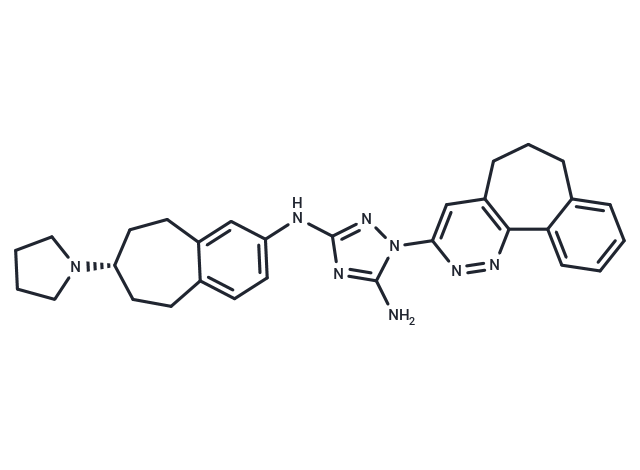Shopping Cart
- Remove All
 Your shopping cart is currently empty
Your shopping cart is currently empty

Bemcentinib (R428) is a selective inhibitor of Axl (IC50: 14 nM) and has been investigated for the treatment of NSCLC.

| Pack Size | Price | Availability | Quantity |
|---|---|---|---|
| 1 mg | $34 | In Stock | |
| 2 mg | $48 | In Stock | |
| 5 mg | $79 | In Stock | |
| 10 mg | $147 | In Stock | |
| 25 mg | $224 | In Stock | |
| 50 mg | $288 | In Stock | |
| 100 mg | $490 | In Stock | |
| 200 mg | $654 | In Stock | |
| 500 mg | $997 | In Stock |
| Description | Bemcentinib (R428) is a selective inhibitor of Axl (IC50: 14 nM) and has been investigated for the treatment of NSCLC. |
| Targets&IC50 | Axl:14 nM (cell free) |
| In vitro | Bemcentinib (R428) activity was limited to the tyrosine kinase subfamily. Of the 133 kinases, Axl was most potently inhibited by R428. With the exception of Tie-2, Ftl-1, Flt-3, Ret, and Abl, kinase inhibition by R428 was at least 10 times lower than observed for Axl. R428 dose-dependently suppressed invasion of both human MDA-MB-231 and murine 4T1 breast cancer cell lines [1]. Addition of R428 (50 nM-1 μM) resulted in a dose-dependent inhibition of differentiation of 3T3-F442A preadipocytes into mature adipocytes. Oil Red O staining ranged between 84 and 35% of that of DMSO control at R428 concentrations between 50 nM and 1 μM. Inhibition of Axl signaling by R428 in differentiating preadipocytes was confirmed by the Axl cell-based assay, yielding lower values (A450) for phospho-Akt activity upon treatment with 1 μM R428 compared with medium control or DMSO control [2]. The Axl inhibitor R428 showed a mean IC50 dose of ~ 2.0μM for the primary CLL B cells after 24 hours of treatment and normal B-, T- and natural killer (NK) cells showed no significant amount of cell death at this dose of R428 (2.5μM) under similar experimental conditions [3]. |
| In vivo | R428 treatment reduced lung metastasis. R428 (7 mg/kg twice daily) significantly suppressed both total metastatic burden and the number of larger metastases. R428 suppressed both tumor angiogenesis and vascular endothelial growth factor (VEGF)–induced corneal neovascularization in vivo [1]. At day 35, the last day of HFD feeding, the body weight in both groups treated with R428 (75 mg/kg/day or 25 mg/kg twice daily, p.o.) was significantly lower than in the corresponding vehicle-treated groups. Compared with the start of the experiment, body weights at the end were significantly increased in both vehicle-treated groups, but not in R428-treated groups [2]. |
| Kinase Assay | A five-point R428 dose titration was performed in radiometric in vitro kinase assays on 133 kinases at the Km(ATP) for each kinase. Axl, Mer, and Tyro3 assays were also performed using a fluorescence polarization protocol. HER2 activity was determined by Z'-LYTE assay [1]. |
| Cell Research | MDA-MB-231 or 4T1 cells (1 × 10^5) were allowed to migrate through Matrigel toward 20% FCS in an 8-μm pore 24-well Transwell plate at 37°C for 16 to 24 h. Noninvaded cells and Matrigel were removed by swabbing. Invaded cells were fixed in 4% formaldehyde, stained with 1% crystal violet, and quantified as for Axl cell-based assay. Cells were preincubated with R428 for 3 h. R428 was added to both upper and lower Transwell chambers [1]. |
| Animal Research | Female BALB/c mice were inoculated in the mammary fat pad with 0.5 × 10^6 4T1 cells. Forty-eight hours after inoculation, mice were randomized into treatment groups (n = 10). Oral dosing with R428 (7–75 mg/kg twice daily) or vehicle continued until days 19 to 21. Cisplatin (1.2 or 4 mg/kg) was administered i.v. once weekly. Body weight and tumor size were measured thrice per week. Lungs were exposed postmortem. Total number and size of surface lung macrometastases were measured (small, <2 mm; medium, ≥2 mm and <3 mm; large, ≥3 mm). Half of each primary tumor was snap frozen in liquid nitrogen. The other half, and the livers were fixed in paraformaldehyde/lysine/periodate solution, paraffin embedded and sectioned (5 μm thick). Two H&E-stained liver sections per animal were examined microscopically for micrometastases in three view fields. Synergism was determined using Clark's synergy calculation [1]. |
| Alias | R428, BGB324 |
| Molecular Weight | 506.64 |
| Formula | C30H34N8 |
| Cas No. | 1037624-75-1 |
| Smiles | Nc1nc(Nc2ccc3CC[C@@H](CCc3c2)N2CCCC2)nn1-c1cc2CCCc3ccccc3-c2nn1 |
| Relative Density. | 1.41 g/cm3 (Predicted) |
| Storage | store at low temperature | Powder: -20°C for 3 years | In solvent: -80°C for 1 year | Shipping with blue ice. | ||||||||||||||||||||
| Solubility Information | H2O: < 1 mg/mL (insoluble or slightly soluble) Ethanol: < 1 mg/mL (insoluble or slightly soluble) DMSO: 5.07 mg/mL (10 mM), Sonication is recommended. | ||||||||||||||||||||
Solution Preparation Table | |||||||||||||||||||||
DMSO
| |||||||||||||||||||||

Copyright © 2015-2025 TargetMol Chemicals Inc. All Rights Reserved.